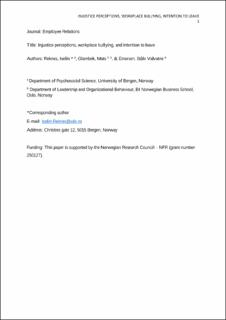| dc.contributor.author | Reknes, Iselin | |
| dc.contributor.author | Glambek, Mats | |
| dc.contributor.author | Einarsen, Ståle | |
| dc.date.accessioned | 2021-06-02T10:51:22Z | |
| dc.date.available | 2021-06-02T10:51:22Z | |
| dc.date.created | 2020-10-03T11:30:40Z | |
| dc.date.issued | 2020 | |
| dc.Published | Employee Relations. 2020, 1-13. | |
| dc.identifier.issn | 0142-5455 | |
| dc.identifier.uri | https://hdl.handle.net/11250/2757366 | |
| dc.description.abstract | Purpose
Intention to leave as an outcome of exposure to workplace bullying is well documented in previous studies, yet, research on explanatory conditions for such an association is lacking.
Design/methodology/approach
The present study investigates the relationship between injustice perceptions, exposure to bullying behaviors and turnover intention, employing a moderated mediation analysis based on a reanalysis and extension of data gathered among a sample of Norwegian bus drivers (N = 1, 024).
Findings
As hypothesized, injustice perceptions were indirectly related to intention to leave via workplace bullying, however, only under conditions of higher perceived injustice levels.
Practical implications
The results underscore the importance of preventing workplace bullying and of maintaining ample levels of justice at work, where employees are treated with fairness and respect.
Originality/value
The study adds important knowledge to the bullying literature by focusing on the role of mechanisms and moderators in bullying situations, investigating how the combination of workplace bullying and injustice perceptions is reflected in employees' intention to leave the organization. | en_US |
| dc.language.iso | eng | en_US |
| dc.publisher | Emerald | en_US |
| dc.rights | Navngivelse-Ikkekommersiell 4.0 Internasjonal | * |
| dc.rights.uri | http://creativecommons.org/licenses/by-nc/4.0/deed.no | * |
| dc.title | Injustice perceptions, workplace bullying and intention to leave | en_US |
| dc.type | Journal article | en_US |
| dc.type | Peer reviewed | en_US |
| dc.description.version | acceptedVersion | en_US |
| dc.rights.holder | Copyright 2020 Emerald Publishing Limited | en_US |
| cristin.ispublished | true | |
| cristin.fulltext | postprint | |
| cristin.qualitycode | 1 | |
| dc.identifier.doi | 10.1108/ER-10-2019-0406 | |
| dc.identifier.cristin | 1836749 | |
| dc.source.journal | Employee Relations | en_US |
| dc.source.pagenumber | 1-13 | en_US |
| dc.relation.project | Norges forskningsråd: 250127 | en_US |
| dc.identifier.citation | Employee Relations. 2020, 43(1), 1-13 | en_US |
| dc.source.volume | 43 | en_US |
| dc.source.issue | 1 | en_US |

